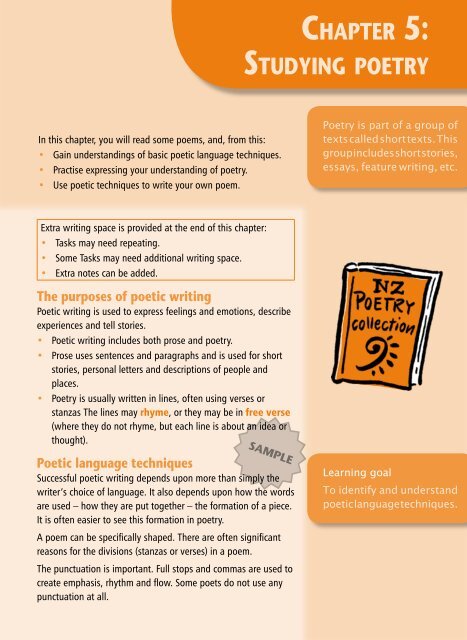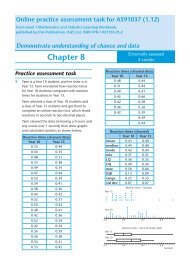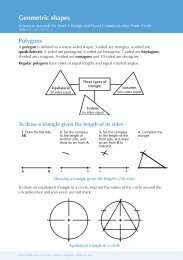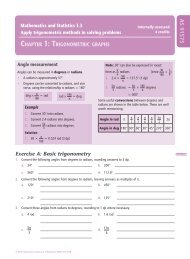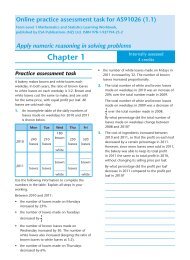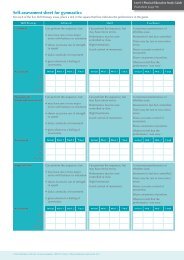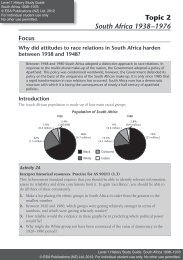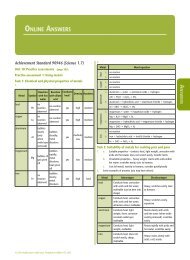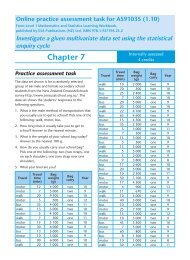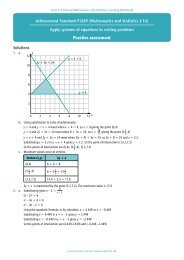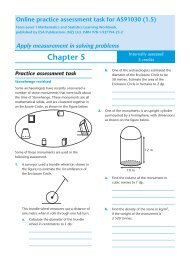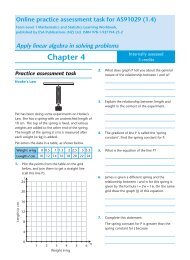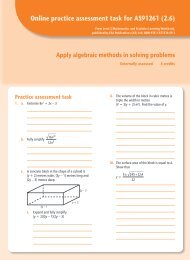CHAPTER 5: STUDYING POETRY
CHAPTER 5: STUDYING POETRY
CHAPTER 5: STUDYING POETRY
Create successful ePaper yourself
Turn your PDF publications into a flip-book with our unique Google optimized e-Paper software.
Chapter 5:<br />
Studying poetry<br />
In this chapter, you will read some poems, and, from this:<br />
• Gain understandings of basic poetic language techniques.<br />
• Practise expressing your understanding of poetry.<br />
• Use poetic techniques to write your own poem.<br />
Poetry is part of a group of<br />
texts called short texts. This<br />
group includes short stories,<br />
essays, feature writing, etc.<br />
Extra writing space is provided at the end of this chapter:<br />
• Tasks may need repeating.<br />
• Some Tasks may need additional writing space.<br />
• Extra notes can be added.<br />
The purposes of poetic writing<br />
Poetic writing is used to express feelings and emotions, describe<br />
experiences and tell stories.<br />
• Poetic writing includes both prose and poetry.<br />
• Prose uses sentences and paragraphs and is used for short<br />
stories, personal letters and descriptions of people and<br />
places.<br />
• Poetry is usually written in lines, often using verses or<br />
stanzas The lines may rhyme, or they may be in free verse<br />
(where they do not rhyme, but each line is about an idea or<br />
thought).<br />
SAMPLE<br />
Poetic language techniques<br />
Successful poetic writing depends upon more than simply the<br />
writer’s choice of language. It also depends upon how the words<br />
are used – how they are put together – the formation of a piece.<br />
It is often easier to see this formation in poetry.<br />
A poem can be specifically shaped. There are often significant<br />
reasons for the divisions (stanzas or verses) in a poem.<br />
The punctuation is important. Full stops and commas are used to<br />
create emphasis, rhythm and flow. Some poets do not use any<br />
punctuation at all.<br />
Learning goal<br />
To identify and understand<br />
poetic language techniques.
82 Year 9 English Learning Workbook<br />
Poems are crafted using imagery – which is language that<br />
creates images in the mind of the reader or listener. Often, a<br />
poem is written to be heard, so read a poem aloud, as it makes<br />
it easier to pick up the rhymes and rhythms of the work.<br />
SAMPLE<br />
Task 5A: Finding the best word<br />
In poetry, words are often chosen by the poet because of their vibrancy or intensity, or for the<br />
emotional depth of meaning the word represents (the connotation of the word).<br />
Replace the highlighted word in each sentence with all the vibrant and colourful words you can<br />
find. An example has been completed for you.<br />
The toddler was dirty.<br />
grubby mucky messy grotty tatty grimy filthy<br />
1. She wore a red dress.<br />
2. He was an old man.<br />
3. The nice car went fast.<br />
4. The film was interesting.<br />
5. It was a good party.<br />
6. School was okay.<br />
7. We went on a nice trip.
Chapter 5: Studying poetry 83<br />
8. Saturdays were boring.<br />
9. The house was in an odd street.<br />
10. We went on an interesting holiday.<br />
11. The family meeting was noisy.<br />
Figures of speech<br />
Figures of speech are another way to gain vibrancy and interest<br />
in the language used in poetic writing. Figures of speech are<br />
techniques used by writers to convey ideas, feelings and images.<br />
Poets use figures of speech to create, rhythm, rhyme and<br />
emotional language to make the reader respond in a specific<br />
way.<br />
Assonance is the repetition of vowel (a, e, i, o and u) sounds.<br />
Assonance is not about the letter. Assonance is about the sound.<br />
Poets use assonance to speed a poem up or slow it down,<br />
depending on the sound used.<br />
SAMPLE<br />
Alliteration is the repetition of consonant sounds at the start of<br />
a word.<br />
Some alliteration creates hard sounds, for example use of the<br />
consonants b and d. Other consonants convey soft sounds, for<br />
example use of f, l and s. These hard and soft sounds are also<br />
used to speed a poem up or slow it down, depending on the<br />
sound used.<br />
Additional theory and Tasks on figures of speech can be found in<br />
Chapter 2 (pages 26–28) and Chapter 7 (pages 124–132).
84 Year 9 English Learning Workbook<br />
Task 5B: Alliteration and assonance<br />
Use the following examples of assonance and alliteration to fill in the table. Some sentences have<br />
alliteration or assonance, some have both. The first two are completed for you.<br />
1. She sells sea shells.<br />
6. Little lapdogs ran around hysterically.<br />
2. It was time to define the rhyme. 7. Bad boys are often trouble.<br />
3. It was the silly season.<br />
8. Good girls gain in the long run.<br />
4. Seventy-seven ships sailed home. 9. The thistle whistled in the blistering wind.<br />
5. The rain fell heavily in Spain. 10. The thief refused to leave the ledge.<br />
Assonance<br />
Alliteration<br />
1. sells shells She sells sea shells.<br />
2. time define rhyme<br />
3.<br />
4.<br />
5.<br />
6.<br />
7.<br />
8.<br />
9.<br />
SAMPLE<br />
10.<br />
Personification<br />
Personification is the technique of giving human qualities<br />
to something that is not human, such as objects or things.<br />
Personification gives things (like the river in the following<br />
example) a personality.<br />
‘The river wrapped her arms around the struggling swimmer and<br />
drew him softly to her embrace, only grudgingly allowing him to<br />
pull free.’
SAMPLE<br />
Chapter 5: Studying poetry 85<br />
Here, the river is described as a living being, a female human<br />
being who is embracing or hugging the swimmer.<br />
What is actually happening is that the swimmer is being<br />
dragged under the water by the currents of the river, although he<br />
eventually pulls free and rescues himself.<br />
Task 5C: Personification<br />
Describe what is actually occurring in the following sentences. Try to avoid using personification at<br />
all in your explanations.<br />
1. The wind skipped and danced around the tree and swept the bird into the dance.<br />
2. He opened the door and the heat smacked into his face.<br />
3. The room spun around and dipped, throwing him off his feet.<br />
4. The tower dominated the street, leaning threateningly over the smaller buildings.<br />
5. The bird knocked on the window and called impatiently to be let in.<br />
6. The wave bounced happily onto the shore before running back to join the others.
86 Year 9 English Learning Workbook<br />
7. The dripping tap plunked quietly to itself, muttering along its pipes.<br />
8. The snake sneaked around the edge of the corner, whispering quietly to itself as it glided along.<br />
9. The bee flew frantically from flower to flower, rushing to get her job finished so she could get off<br />
duty.<br />
10. The couch sulked in the corner.<br />
Task 5D: Onomatopoeia<br />
Onomatopoeia is where a word echoes real-life sounds and actions.<br />
See how many onomatopoeic words you can add to the following list:<br />
Plunk<br />
Drip<br />
Plop<br />
Bang<br />
Slap<br />
Tapping<br />
SAMPLE
Chapter 5: Studying poetry 87<br />
Metaphors<br />
A metaphor is used to highlight specific qualities of a thing or<br />
person. Metaphors are a comparison, where one thing is said to<br />
be another. (Metaphors do not use like or as.)<br />
For example, ‘He is the sunshine in my life’ – here the metaphor is<br />
being used to express the absolute importance and the warmth<br />
of the person in the life of the writer.<br />
Similes<br />
A simile is also used to highlight qualities of a person or thing.<br />
Similes always use like or as.<br />
For example, She shone like the sun.<br />
The comparison also highlights qualities of warmth and<br />
sustenance, but it does so using the word like.<br />
The metaphor says he is the sun, the simile says she is like the sun.<br />
SAMPLE<br />
Task 5E: Metaphors and similes<br />
Change the following metaphors into similes and similes into metaphors. The first two have been<br />
done for you.<br />
Metaphors<br />
He is the sunshine of my life.<br />
She snakes around the corners.<br />
Similes<br />
He is warm and nurturing like sunshine in my life.<br />
She slides like a snake around corners.<br />
1. He swam like a fish.<br />
2. She parroted everybody.<br />
3. He had eyes like saucers.<br />
4. She dogged him all day.<br />
5. She had ears like a fox.<br />
6. The baby trumpeted her distress.<br />
7. Her neck was like a swan’s.<br />
8. Her hair was corkscrew curls.<br />
9. She hissed and spat cattily at the girl.<br />
10. She had feet like barges.<br />
11. He had a memory like an elephant.
88 Year 9 English Learning Workbook<br />
12. He was green with envy.<br />
13. She was an angel all day.<br />
14. He was blind as a bat.<br />
15. Her heart broke with a loud crack.<br />
16. He punched him with words.<br />
17. He was childlike.<br />
18. The trees stood like sentries.<br />
Rhythm and rhyme<br />
The rhythm of a poem is its beat, which is how it sounds when<br />
it is read aloud. The rhythm is also about how it flows.<br />
• Is it a fast or a slow poem?<br />
• Do the words encourage you to read it at a certain speed?<br />
• Does the poet use simple words or complicated ones?<br />
• Is the subject of the poem weighty or frivolous?<br />
These all affect how the poem is read, so they are all about the<br />
poem’s rhythm.<br />
Rhyme is the repetition of final vowel and consonant sounds in<br />
words.<br />
Words that sound the same, or almost the same, attract our<br />
attention and are easy to remember.<br />
SAMPLE<br />
You need to take note of where the rhymes are in the poem – at<br />
the end of every line or every alternate line? Where the rhyme<br />
falls dictates the pattern and speed of the poem.
Answers 213<br />
Chapter 5: Studying poetry<br />
Task 5A: Finding the best word (page 82)<br />
1. scarlet / fiery / bright / bold / raspberry / crimson / ruby / cherry.<br />
2. ancient / elderly / aged / older / mature.<br />
3. fabulous / sporty / good / fine / lovely.<br />
4. appealing / exciting / fascinating / remarkable.<br />
5. fine / interesting / first-rate / exciting.<br />
6. adequate / all right / satisfactory / tolerable / acceptable.<br />
7. fact-finding / fascinating / interesting / pleasant / good / fine / lovely.<br />
8. tedious / dull / uninteresting / tiresome.<br />
9. strange / peculiar / unusual / quirky / weird.<br />
10. appealing / exciting / fascinating / remarkable.<br />
11. rowdy / chaotic / raucous / tumultuous.<br />
Task 5B: Alliteration and assonance (page 84)<br />
Assonance<br />
Alliteration<br />
1. sells shells She sells sea shells.<br />
2. time define rhyme<br />
3. silly season<br />
4. seventy seven ships sailed<br />
5. rain Spain<br />
6. little lapdogs hysterically<br />
7. bad boys<br />
8. good girls gain<br />
9. thistle whistled blistering wind<br />
10. leave ledge leave ledge<br />
Task 5C: Personification (page 85)<br />
Suggested answers<br />
1. The bird got caught in the wind and was swept off the branch.<br />
2. He felt the warmth of the room on his face as he opened the door.<br />
3. He felt dizzy and fell over.<br />
4. The tower was taller then any other building in the street.<br />
5. The bird sung and pecked on the window.<br />
SAMPLE
214 Year 9 English Learning Workbook<br />
6. The sea rolled onto the beach in waves.<br />
7. The water moved through the pipes, making a noise and then dripped into the sink.<br />
8. The snake slid around the corner of the building.<br />
9. The bee flew quickly from flower to flower.<br />
10. The couch had been placed in the corner of the room.<br />
Task 5D: Onomatopoeia (page 86)<br />
Plunk<br />
Drip<br />
Plop<br />
Bang<br />
Plunk<br />
Donk<br />
Tinkle<br />
Smash<br />
Clamour<br />
Ripping<br />
Slap<br />
Tapping<br />
Pitter-patter<br />
Dollop<br />
Blip<br />
Tingle<br />
Ring<br />
Shatter<br />
Yell<br />
Shout<br />
SAMPLE<br />
Task 5E: Metaphors and similes (page 87)<br />
Metaphors<br />
Similes<br />
1. He dolphined through the waves. He swam like a fish.<br />
2. She parroted everybody. She repeated everything said, like a parrot.<br />
3. His eyes saucered with fright. He had eyes like saucers.<br />
4. She dogged him all day. She followed him around like a puppy.<br />
5. Her fox ears pricked up. She had ears like a fox.<br />
6. The baby trumpeted her distress. The baby’s cry sounded like a trumpet.<br />
7. She stretched her swan neck gently. Her neck was like a swan’s.<br />
8. Her hair was corkscrew curls. The curls in her hair looked like corkscrews.<br />
9. She hissed and spat cattily at the girl. She hissed like a cat at the other girl.<br />
10. Her boat feet were just too large. She had feet like barges.<br />
11. His elephantine memory won them the quiz. He had a memory like an elephant.<br />
12. He was green with envy. Jealously he looked on, as green as grass with envy.<br />
13. She was an angel all day. She was like a little angel.
Answers 215<br />
14. His little bat eyes blinked blindly. He was blind as a bat.<br />
15. Her heart broke with a loud crack. Her heart felt as if it was broken.<br />
16. He punched him with words. His words felt like punches.<br />
17. He behaved like a six-foot-high child. He was childlike.<br />
18. The tree sentries stood implacably. The trees stood like sentries.<br />
Task 5F: Rhythm and rhyme (page 89)<br />
slows<br />
south<br />
snow<br />
mouth<br />
1. stir demur<br />
2. hold gold<br />
3. flowing growing<br />
4. foal pole<br />
5. sea me<br />
6. land sand<br />
7. remember Reinga<br />
8. law paw<br />
9. boast coast<br />
SAMPLE<br />
10. shore forevermore<br />
11. shore yours<br />
Task 5G: Finding the rhythm (page 91)<br />
Speed Up<br />
Slow Down<br />
Thundering a shoreline back upon the sand Sighing, saltless waters<br />
too wild, too great<br />
fetlocks burning<br />
Rushed up, uncalkined<br />
in came the morning<br />
footloose mountains<br />
taunted Magellan<br />
Massive and flying and nothing to me<br />
homesick for its snowshed<br />
Tua Marina murmurs<br />
lonely, long demur<br />
Paradisal grasses, knee-deep<br />
glitter of a solstice<br />
smoulder of autumns<br />
Bluff folds down


